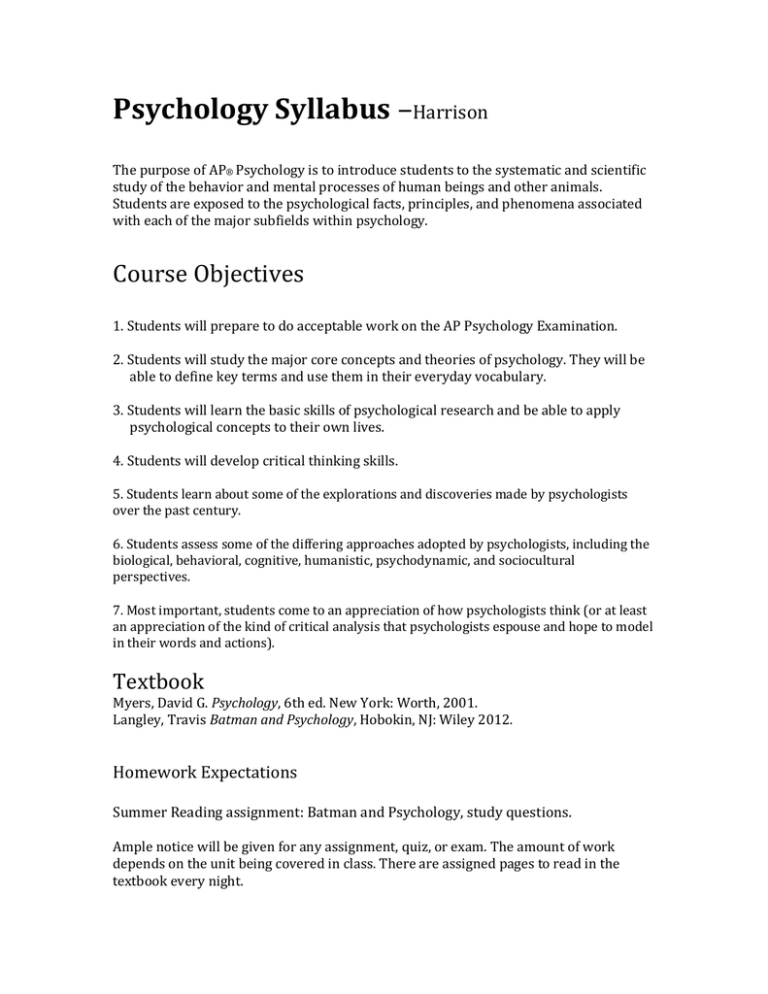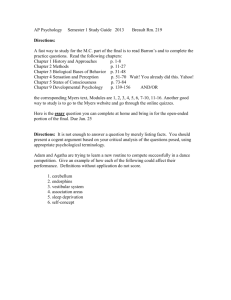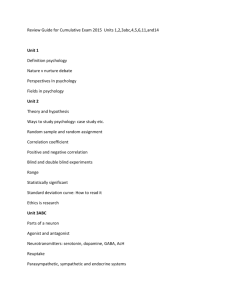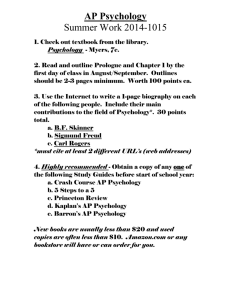Psychology Syllabus –Harrison
advertisement

Psychology Syllabus –Harrison The purpose of AP® Psychology is to introduce students to the systematic and scientific study of the behavior and mental processes of human beings and other animals. Students are exposed to the psychological facts, principles, and phenomena associated with each of the major subfields within psychology. Course Objectives 1. Students will prepare to do acceptable work on the AP Psychology Examination. 2. Students will study the major core concepts and theories of psychology. They will be able to define key terms and use them in their everyday vocabulary. 3. Students will learn the basic skills of psychological research and be able to apply psychological concepts to their own lives. 4. Students will develop critical thinking skills. 5. Students learn about some of the explorations and discoveries made by psychologists over the past century. 6. Students assess some of the differing approaches adopted by psychologists, including the biological, behavioral, cognitive, humanistic, psychodynamic, and sociocultural perspectives. 7. Most important, students come to an appreciation of how psychologists think (or at least an appreciation of the kind of critical analysis that psychologists espouse and hope to model in their words and actions). Textbook Myers, David G. Psychology, 6th ed. New York: Worth, 2001. Langley, Travis Batman and Psychology, Hobokin, NJ: Wiley 2012. Homework Expectations Summer Reading assignment: Batman and Psychology, study questions. Ample notice will be given for any assignment, quiz, or exam. The amount of work depends on the unit being covered in class. There are assigned pages to read in the textbook every night. Vocabulary terms are also given for each unit. Quizzes are administered frequently, at least once a unit. The quizzes range from using fill-in-the-blank, short answer, and/or multiple-choice questions. Exams will be given at the end of each unit. (simulating the AP Exam). Other assignments given to students are class presentations, group projects, and papers. These assignments vary with the unit being covered. Course Plan Unit I: History, Approaches and Research Methods -- 3 weeks Myers, David G. Psychology, Chapter 1 A. Logic, Philosophy, and History of Science B. Approaches/Perspectives C. Experimental, Correlation, and Clinical Research D. Statistics E. Research Methods and Ethics Objectives • Define psychology and trace its historical development. • Compare and contrast the psychological perspectives. • Identify basic and applied research subfields of psychology. • Identify basic elements of an experiment (variables, groups, sampling, population, etc.). • Compare and contrast research methods (case, survey, naturalistic observation). • Explain correlational studies. • Describe the three measures of central tendency and measures of variation. • Discuss the ethics of animal and human research. Unit II: Biological Basis of Behavior 3 weeks Myers, David G. Psychology, Chapter 2 A. Physiological Techniques (e.g., imagining, surgical) B. Neuroanatomy C. Functional Organization of Nervous System D. Neural Transmission E. Endocrine System F. Genetics Objectives • Describe the structure of a neuron and explain neural impulses. • Describe neuron communication and discuss the impact of neurotransmitters. • Classify and explain major divisions of the nervous system. • Describe the functions of the brain structures (thalamus, cerebellum, limbic system, etc.). • Identify the four lobes of the cerebral cortex and their functions. • Discuss the association areas. • Explain the split-brain studies. • Describe the nature of the endocrine system and its interaction with the nervous system. Unit III: Developmental Psychology 3 weeks Myers, David G. Psychology, Chapter 3-4 A. Life-Span Approach B. Research Methods C. Heredity–Environment Issues D. Developmental Theories E. Dimensions of Development F. Sex Roles, Sex Differences Objectives • Discuss the course of prenatal development. • Illustrate development changes in physical, social, and cognitive areas. • Discuss the effect of body contact, familiarity, and responsive parenting on attachments. • Describe the benefits of a secure attachment and the impact of parental neglect and separation as well as day care on childhood development. • Describe the theories of Piaget, Erikson, and Kohlberg. • Describe the early development of a self-concept. • Distinguish between longitudinal and cross-sectional studies. Unit IV: States of Consciousness 2 weeks Myers, David G. Psychology, Chapter 7 A. Sleep and Dreaming B. Hypnosis C. Psychoactive Drug Effects Objectives • Describe the cyclical nature and possible functions of sleep. • Identify the major sleep disorders. • Discuss the content and possible functions of dreams. • Discuss hypnosis, noting the behavior of hypnotized people and claims regarding its uses. • Discuss the nature of drug dependence. • Chart names and effects of depressants, stimulants, and hallucinogenic drugs. • Compare differences between NREM and REM. • Describe the physiological and psychological effects of depressants, stimulants, and hallucinogens. Unit V: Sensation & Perception 3 weeks Myers, David G. Psychology, Chapter 5-6 A. Thresholds B. Sensory Mechanisms C. Sensory Adaptation D. Attention E. Perceptual Processes Objectives • Contrast the processes of sensation and perception. • Distinguish between absolute and difference thresholds. • Label a diagram of the parts of the eye and ear. • Describe the operation of the sensory systems (five senses). • Explain the Young-Helmholtz and opponent-process theories of color vision. • Explain the place and frequency theories of pitch perception. • Discuss Gestalt psychology’s contribution to our understanding of perception. • Discuss research on depth perception and cues. Unit VI: Learning 2 weeks Myers, David G. Psychology, Chapter 8 A. Classical Conditioning B. Operant Conditioning C. Cognitive Processes in Learning D. Biological Factors E. Social Learning (Observational Learning) Objectives • Describe the process of classical conditioning (Pavlov’s experiments). • Explain the processes of acquisition, extinction, spontaneous recovery, generalization, and discrimination. • Describe the process of operant conditioning, including the procedure of shaping, as demonstrated by Skinner’s experiments. • Identify the different types of reinforcers and describe the schedules of reinforcement. • Discuss the importance of cognitive processes and biological predispositions in conditioning. • Discuss the effects of punishment on behavior. • Describe the process of observational learning (Bandura’s experiments). Unit VII: Memory 2 weeks Myers, David G. Psychology, Chapter 9 A. Memory Objectives • Describe memory in terms of information processing, and distinguish among sensory memory, short-term memory, and long-term memory. • Distinguish between automatic and effortful processing. • Explain the encoding process (including imagery, organization, etc.). • Describe the capacity and duration of long-term memory. • Distinguish between implicit and explicit memory. • Describe the importance of retrieval cues. Discuss the effects of interference and motivated forgetting on retrieval. • Describe the evidence for the constructive nature of memory. Unit VIII: Thinking and Language 2 weeks Myers, David G. Psychology, Chapter 10 A. Language B. Thinking C. Problem Solving and Creativity Objectives • Describe the nature of concepts and the role of prototypes in concept formation. • Discuss how we use trial and error, algorithms, heuristics, and insight to solve problems. • Explain how the representativeness and availability heuristics influence our judgments. • Describe the structure of language (phonemes, morphemes, grammar). • Identify language developmental stages (babbling, one word, etc.). • Explain how the nature-nurture debate is illustrated in the theories of language development. • Discuss Whorf’s linguistic relativity hypothesis. • Describe the research on animal cognition and communication. Unit IX: Motivation and Emotion 2 weeks Myers, David G. Psychology, Chapter 12-13-14 A. Biological Bases B. Theories of Motivation C. Hunger, Thirst, Sex, and Pain D. Social Motives E. Theories of Emotion F. Stress Objectives • Define motivation and identify motivational theories. • Describe the physiological determinants of hunger. • Discuss psychological and cultural influences on hunger. • Define achievement motivation, including intrinsic and extrinsic motivation. • Identify the three theories of emotion (James-Lange, Cannon-Bard, Schachter-Singer). • Describe the physiological changes that occur during emotional arousal. • Discuss the catharsis hypothesis. • Describe the biological response to stress. Unit X: Testing and Individual Differences 2 weeks Myers, David G. Psychology, Chapter 11 A. Standardization and Norms B. Reliability and Validity C. Types of Tests D. Ethics and Standards in Testing E. Intelligence F. Heredity/Environment and Intelligence G. Human Diversity Objectives • Trace the origins of intelligence testing. • Describe the nature of intelligence. • Identify the factors associated with creativity. • Distinguish between aptitude and achievement tests. • Describe test standardization. • Distinguish between the reliability and validity of intelligence tests. • Describe the two extremes of the normal distribution of intelligence. • Discuss evidence for both genetic and environmental influences on intelligence. • Discuss whether intelligence tests are culturally biased. Unit XI: Personality 2 weeks Myers, David G. Psychology, Chapter 15 A. Personality Theories and Approaches B. Assessment Techniques C. Self-concept/Self-esteem D. Growth and Adjustment Objectives • Describe personality structure in terms of the interactions of the id, ego, and superego. • Explain how defense mechanisms protect the individual from anxiety. • Describe the contributions of the neo-Freudians. • Explain how personality inventories are used to assess traits. • Describe the humanistic perspective on personality in terms of Maslow’s focus on selfactualization and Rogers’ emphasis on people’s potential for growth. • Describe the impact of individualism and collectivism on self-identity. • Describe the social-cognitive perspective on personality. • Discuss the consequences of personal control, learned helplessness, and optimism. Unit XII: Abnormal Psychology 2 weeks Myers, David G. Psychology, Chapter 16 A. Definitions of Abnormality B. Theories of Psychopathology C. Diagnosis of Psychopathology D. Anxiety Disorders E. Somatoform Disorders F. Mood Disorders G. Schizophrenic Disorders H. Organic Disorders I. Personality Disorders J. Dissociative Disorders Objectives • Identify the criteria for judging whether behavior is psychologically disordered. • Describe the medical model of psychological disorders. • Describe the aims of DSM-IV, and discuss the potential dangers of diagnostic labels. • Describe the symptoms of generalized anxiety disorder, phobias, obsessivecompulsive disorder, and posttraumatic stress disorder. • Describe and explain the development of somatoform and mood disorders. • Describe the various symptoms and types of schizophrenia. • Describe the nature of organic and personality disorders. • Describe the characteristics and possible causes of dissociative disorders. Unit XIII: Treatment of Psychological Disorders 2 weeks Myers, David G. Psychology, Chapter 17 A. Treatment Approaches B. Modes of Therapy (e.g., individual, group) C. Community and Preventive Approaches Objectives • Discuss the aims and methods of psychoanalysis. • Identify the basic characteristics of the humanistic therapies. • Identify the basic assumptions of behavior therapy. • Describe the assumptions and goals of the cognitive therapies. • Discuss the benefits of group therapy and family therapy. • Discuss the findings regarding the effectiveness of the psychotherapies. • Discuss the role of values and cultural differences in the therapeutic process. • Identify the common forms of drug therapy and the use of electroconvulsive therapy. Unit XIV: Social Psychology 2 weeks Myers, David G. Psychology, Chapter 18 A. Group Dynamics B. Attribution Process C. Interpersonal Perception D. Conformity, Compliance, Obedience E. Attitudes and Attitude Change F. Organizational Behavior G. Aggression/Antisocial Behavior Objectives • Describe the importance of attribution in social behavior. • Explain the effect of role-playing on attitudes in terms of cognitive dissonance theory. • Discuss the results of Asch’s experiment on conformity. • Describe Milgram’s controversial experiments on obedience. • Discuss how group interaction can facilitate group polarization and groupthink. • Describe the social, emotional, and cognitive factors that contribute to the persistence of cultural, ethnic, and gender prejudice and discrimination. • Discuss the issues related to aggression and attraction. • Explain altruistic behavior in terms of social exchange theory and social norms. Assessment Unit Tests These tests are modeled on the AP Exam, with 50 multiple-choice questions and one essay to be completed in 60 minutes. Quizzes These are randomly scheduled and use the multiple-choice format. Midterm Exam Students take a midterm exam covering the first six units. The exam is in the same format as the AP Exam (multiple-choice and short essays), but the number of multiple-choice questions is reduced proportionately to the time available in the exam period to maintain a similar time pressure. Additional Assessments Unit Journals Students continue writing in their double-entry journals approximately twice each week throughout the course. These journals facilitate deep processing of learning and differentiation of instruction by encouraging critical thinking and independent exploration. They also provide an additional forum for the teacher to give feedback to guide individual students. Entries must be linked to the unit that is being studied and contain the following elements: student reflection on readings discussions and activities personal experiences recent news or television broadcasts, or Internet research Projects Naturalistic Observation Each student completes a 15-minute observation of a human participant in a naturalistic setting. The purpose is to familiarize students with this method, to improve their powers of observation, and to help them distinguish between subjective and objective records. Experimental Design Students are given a hypothetical research problem and told to write a proposal for a controlled experiment to solve it. The exercise serves to improve their understanding of research methodology. Behavior Modification Each student designs an application of operant conditioning principles to modify a human participant’s behavior. After receiving approval, students attempt the modification over a three-week period. The project develops firsthand experience of Skinner’s theory. Applications of Developmental Psychology Students work in small groups to research a recent topic related to the unit on development (e.g., the benefits of Head Start programs, effectiveness of sex or drug education programs, effects of divorce on children) and then present their findings to the class in an oral report of 15 to 20 minutes. The project provides an introduction to library and online research tools in psychology as well as APA documentation. Controlled Experiment Students research a topic of their choice. The final project must incorporate a review of literature, discussion of method, presentation and evaluation of results, and a conclusion. Poster Presentation Students present the results of their second-semester project to the class. Presentation is in poster form accompanied by a 30-minute lecture.




